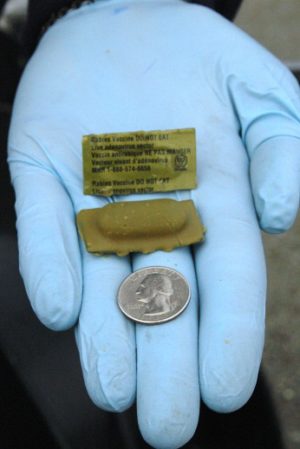We don’t think about rabies much in this country, but it’s out there. The disease tends to pass through wild populations of animals in waves, mostly commonly affecting foxes, raccoons, skunks and bats. On the East Coast, as is shown by this CDC map, raccoons are the most common carrier, although not by much. In Puerto Rico, by contrast, the mongoose is the usual culprit.
One way to control rabies is to scatter vaccine around the woods, hidden inside tasty treats, as part of the Oral Rabies Vaccine Bait Drop program. Canada and the U.S. have done this for a while in various locations. Field tests have started again recently in five states, with bait drops out of planes and cars in areas including Grafton and Coos counties in northern New Hampshire. The bait is a blister pack filled with the vaccine and coated with a sweet attractant. When an animal bites into a bait it will release the vaccine into their mouth and, with an adequate dose, develop immunity to rabies.
Reports the CDC: “Humans and pets cannot get rabies from contact with the bait, but are asked to leave the bait undisturbed if they encounter it. If contact with bait occurs, the contact area should be immediately rinsed with warm water and soap. Each bait carries a toll-free number that people can call if they have additional questions concerning a bait contact.”
So if you’re hiking north of the notches and see a funky-looking packet on the ground … don’t eat it.


 Return to the Concord Monitor
Return to the Concord Monitor